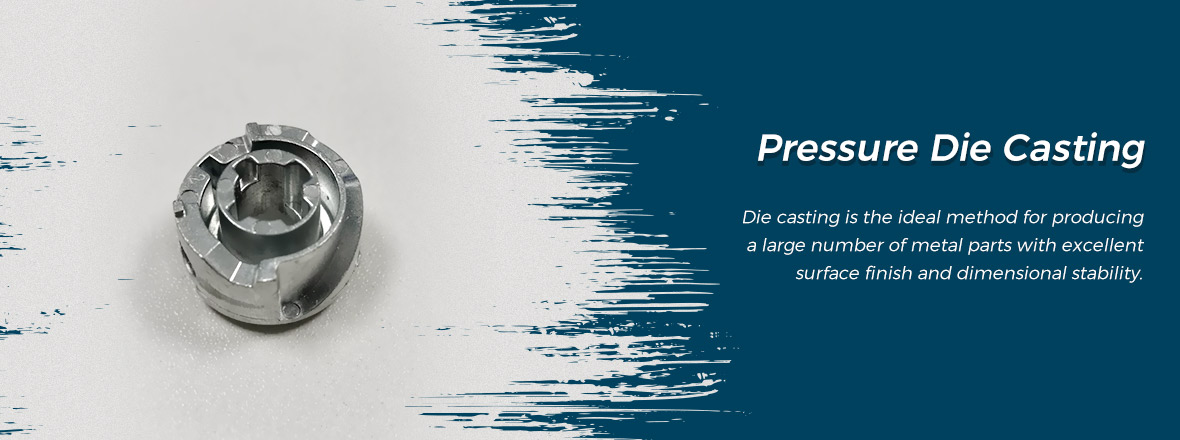Pressure Die Casting
Pressure die casting is a metal casting process. It is characterized by applying high pressure to the molten metal using the mold cavity. Molds are usually machined from stronger alloys, a process similar to injection molding. Most die castings are iron-free, such as zinc, copper, aluminum, magnesium, lead, tin, and lead-tin alloys and their alloys. Depending on the type of die casting, a cold chamber dies casting machine or a hot chamber die casting machine is required.
Pressure casting is a special casting method that has developed rapidly in modern metal processing technology with little or no cutting. It is the process of filling molten mold under high pressure and high speed and crystallizing and solidifying under high pressure to form castings. High pressure and high speed are the main features of pressure casting. The commonly used pressure is tens of MPa, the filling speed (in-gate speed) is about 16 to 80 m / s, and the time for filling the mold cavity with metal liquid is extremely short about 0.01 to 0.2 seconds.
Advantages of the pressure die casting
Die casting is the ideal method for producing a large number of metal parts with excellent surface finish and dimensional stability.
HPDC's production cycle includes:
1. Metering of metal into the shot sleeve.
2. Plunger movement.
3. Rapid die filling. The steel dies, typically 200-300°C, dissipates the latent heat.
4. During solidification, the casting is pressurized hydraulically by the plunger to feed the solidification shrinkage. Locking forces up to 4000 tons are commercially available to withstand the large pressures
5. The die is opened.
6. The casting is then ejected. The hydraulic energy is provided by a computerized system that permits control of metal position, velocity and plunger acceleration to optimize the flow and the pressure during filling and solidification.
Application of Pressure Die Casting
Numărul de piese variază de la 50 sau 100 din piesele prototip la mii de cerințe de producție în serie - toate acestea fiind produse într-un mod atent și precis pe care le aplicăm tuturor proiectelor.
- Piese auto precum roți, blocuri, chiulase, colectoare etc.
- Piese turnate aerospațiale.
- Carcase motor electric.
- Obiecte de bucătărie precum oala sub presiune.
- Dulapuri pentru industria electronică.
- Aparate hardware generale, piese de pompare, piese sanitare.
Echipamentele de turnare sub presiune ale Essai au capacitatea de a prelucra matrițe interne și pot produce matrițe cu o greutate de 2,5 kg și o dimensiune de până la 500x500x250mm. Avem 10 mașini de turnare sub presiune cu forțe de prindere cuprinse între 80T și 630T. Materialele de turnare utilizate în mod obișnuit sunt aluminiu (de obicei ADC10 / 12 și A380) și zinc (3 # / 5 #). Turnările pot fi, de asemenea, supuse unui număr mare de procese secundare în propriile instalații de prelucrare Essai, precum și la diverse procese cosmetice, inclusiv acoperire cu pulbere, acoperire prin pulverizare, anodizare, lustruire și galvanizare.
1. Turnarea prin matrițare de înaltă presiune poate fi împărțită în procese cu „cameră rece” și „cameră fierbinte”.
2. În procesul camerei reci, metalul topit este contorizat într-o cameră rece pentru fiecare ciclu de mașină (sau împușcat).
3. The molten metal is then forced by a single plunger through a narrow feeder channel (or gate), into the die cavity itself, by the application of pressures from 7 to 207 MPa.
4. The metal solidifies rapidly because the die is water-cooled within a fraction of a second.
5. Upon solidification, the dies are opened and the casting is removed using ejector pins.
6. Most of the castings will have flash where the two die halves come together. This is usually removed in a trimming die.
7. The high cost of dies (up to £250,000) and the capital cost of machines (£175,000–£350,000) limit this process to the high volume production of components.
8. Hot-chamber die casting is limited to the low melting point magnesium and zinc alloys, where contamination by the iron will be less extensive. A gooseneck shot sleeve is submerged in a heated pot of molten melt. A plunger descends and forces the molten metal into the die. As the piston retracts, the cylinder is filled with metal.
1. High pressure dies casting is restricted to the lower melting point alloys.
2. The bulk of die casting is carried out in zinc-, magnesium- and aluminum-based alloys.
3. The most popular zinc-based alloys (known as Mazak) contain 3.8–4.3% aluminum and 0.10–1.25 wt% copper, with tensile strengths of 293–355 MPa, and elongations of 3–4%. Zinc alloys have a higher impact strength than die-cast aluminum alloys.
4. There is six main aluminum die casting alloys used in the UK. All contain 4–13 wt% silicon, which is used to promote good castability. The most common alloy is LM6-M (BS 1490), which contains 10–13% silicon, and has a tensile strength of 280 MPa and an elongation of 2–5%.
5. The strict melting practice is required with magnesium-based alloys, which are mainly used on hot-chamber machines. The most popular alloy contains 9–10% aluminum and 1% zinc, achieves a tensile strength of 215 MPa and an elongation of 2%.
6. The degree of retained porosity in the die casting affects the properties of the product.
Bine ați venit pentru a vă începe afacerea acum!
Contactează-ne




